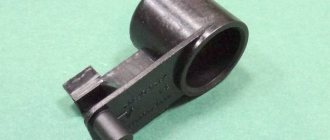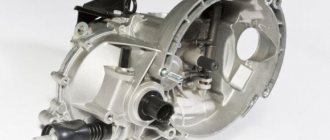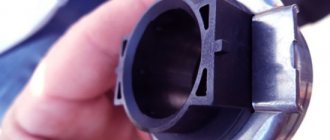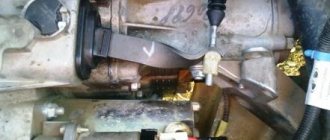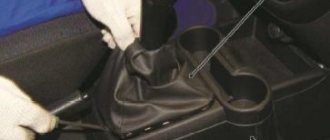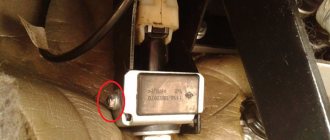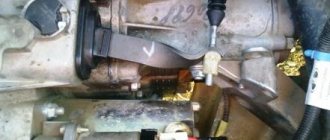April 30, 2019 Lada.Online 147 245 111
Adaptation of the automated transmission (AMT) is necessary for the correct operation of the clutch release actuator. If this operation is not performed, then malfunctions in the operation of the transmission may occur (jerks, jolts while driving, as well as increased wear of the clutch). AMT adaptation should be performed as the clutch wears out or after replacing it. You can perform AMT adaptation at the LADA dealership or yourself.
Attention! You perform all actions at your own peril and risk. The instructions were written not by specialists/engineers, but from the words of owners of Lada Vesta and Lada XRAY (SrgKlsnkv and sva775) cars. The procedure was not tested on other LADA models with AMT (Granta, Kalina, Priora).
Required
:
- adapter ELM327 (available in the AliExpress catalog)
What is adaptation and when is it carried out?
Adaptation of a robotic gearbox is the process of resetting the existing settings of the electronics that control the unit. Subsequently, the device is calibrated for new operating modes, ensuring smooth gear shifting and proper clutch operation. The manual transmission adaptation procedure is carried out in the event of malfunctions in its operation, as well as when performing various repair work on the transmission, in particular:
- Complete replacement of a robotic gearbox or its partial repair with disassembly.
- Replacement of the electronic transmission control unit, the electric drive responsible for changing gears.
- Replacement of failed sensors that control the operation of the robotic gearbox.
- Replacement or repair of the clutch drive and sensors, as well as other parts that make up the clutch mechanism.
Adaptation of the device should only be carried out in cases where it is really necessary. Carrying out this procedure too frequently has a negative impact on the clutch assembly and leads to premature wear of the units. Possible positive effects that appear after frequent adaptation are short-term. Here are some of the most common misconceptions regarding robotic box adaptation:
- The procedure does not affect the smoothness when the car starts to move.
- Adaptation will not help prevent jerking when driving at low speeds if other transmission parts are worn.
- The position of the rack in the clutch mechanism does not indicate the need for adaptation.
Fresh questions for auto repair shops (adaptation of the vaz lada granta robot) in Moscow
Good afternoon. The steering rack of the electric power steering on Toyota Avensis cars produced in 2009 rattled. 1) where can I get diagnostics done? 2) how much will the repair cost? tel. 8-916-804-59-01
Good evening. Can you repair the abs block from a 2006 ford fiesta
Hello, do you deal with ZAZ cars?
Good evening. Please tell me, do you remove the catalyst and particulate filter on Santa Fe, diesel 2016? V.? How much will all the work cost?
Source
Typical faults
You can often hear that robotic gearboxes are extremely unreliable. The first models of such units actually failed quite often, but newer models are slightly inferior to traditional manual and automatic transmissions in survivability and performance. The fact that they are becoming increasingly popular in the automotive industry also speaks in favor of robot boxes. However, their characteristic malfunctions are worth talking about. The main symptoms of malfunctions include:
- Clutch slipping;
- Too slow response to increasing engine speed;
- The appearance of sound noise (knocking, buzzing or howling);
- Operation of the indicator light on the dashboard;
- Jerks when automatically shifting gears during smooth movement;
- Leaking transmission fluid;
- Complete failure of the transmission.
As the reader already knows, automatic transmissions are essentially modified “mechanics”, which means they are characterized by the same malfunctions as conventional manual transmissions. In particular:
- Worn speed selector fork;
- Wear of rolling bearings.
Electrical components of the manual transmission can also fail. Despite the fact that almost all electrics in robotic units have a long service life, breakdowns are not uncommon. Especially when it comes to manual transmission of obsolete models. The following malfunctions can be noted:
- Burnout of contacts of electric drives;
- Damage to wiring;
- Failure of sensors;
- Burnout of contact groups;
- Control unit malfunction.
As a rule, electrical equipment fails due to overheating.
It is important for a car enthusiast to monitor the performance of the cooling system. For example, the system channels may become clogged - this will lead to obstructed coolant flow with subsequent overheating of individual manual transmission elements
It is also worth monitoring the condition of the oil. Not only does it prevent dry friction, but it also absorbs and removes excess heat.
Some conclusions
Summarizing the various information reported by Kalina-2 owners on forums, we can draw the following conclusion. No one has any complaints about the operation of the engine, gearbox or transmission, and never had any. Complaints, as a rule, are caused by the quality of the implementation of additional options. Many of which, by the way, can be called excessive luxury for a car of this class. All existing complaints relate only to the blocks and parts that VAZ purchases from suppliers, and not to the main components of the car. There is nothing more to add here.
Not long ago, the AvtoVAZ Lada Kalina model was released for sale, operating on an automatic transmission.
In principle, a robotic box can be called a modified unit. It is worth noting that this type of transmission is installed only on units with a volume of 1.6 liters and a power of 98 hp.
What is a robotic box?
A robotic gearbox is essentially a complex mechanical device with additional electronic components that control its operation. The electronics themselves are responsible for changing speeds and operating the clutch; the driver only gives the appropriate commands using the lever. The digital unit takes into account the vehicle's driving mode, driving style and other conditions, ensuring smooth movement and minimizing wear of parts.
From the driver's point of view, the robotic gearbox allows you to drive with the same comfort as when using an automatic transmission. But at the same time, its use makes it possible to use fuel more economically. And the unit itself is more reliable and costs less than its fully automatic counterpart.
For correct operation, once a year or every 10-15 thousand mileage, it is necessary to adapt the robotic box so that the electronic filling takes into account the wear of transmission parts or is adjusted after replacing components and assemblies. This procedure should only be performed at specialized service stations that have the necessary equipment, knowledge and experience.
A few words about adaptive boxes
The familiar automatic machine, made on the basis of a torque converter, appeared about 80 years ago. Since then, automatic transmissions have been actively equipped not only with hydraulic and mechanical elements, but also with their modern basis - electronics. The emergence of microprocessor technologies in the early 80s made it possible not only to enhance the electronization of the machine, but to truly take it to a new level. That is why, about 30 years ago, the first learning gearboxes, called “adaptive,” began to appear.
Such automatic transmissions have one truly significant difference from their predecessors. Its essence lies in the fact that the electronic “brain” of the box not only controls it according to programmed algorithms, but also modifies them based on the style, manner and driving conditions of a particular motorist. Surprisingly, adaptive gearboxes instantly replaced conventional automatic transmissions from the “stage” of their performance, and today the latter can only be found on cars of the early 80s and 90s. All models released later were already equipped with a learning machine.
All automatic transmissions have exclusively individual adaptation methods and algorithms, but most devices have two learning modes:
- Long-term adaptation, carried out by the gearbox after a long mileage (about 200-1,000 kilometers). During such training, the machine gets used to the average driving style of the motorist and sets the settings specifically for him, which over time become standard for the device;
- Rapid adaptation, which occurs within a very short time (from several hundred meters to a couple of kilometers). This training occurs constantly and adjusts the operation of the automatic transmission to the driving mode specifically at a given time. Naturally, if the movement is organized as usual, then the machine will not be rebuilt in a new way.
This combination of adaptive modes made it possible to organize the highest quality and most convenient operation of modern automatic transmissions. Of course, adaptation is not at the highest level, but smart boxes are becoming less and less “stupid”. Note that some old machines have only one training mode.
In move
I checked how the Lada Vesta drives with such a box. In 5th gear the revs stay just above 1500. Of course, the load on the engine is light, but the car goes uphill. This is not very correct or comfortable. The motor is running tight, not in the best mode. Even when the speed is reduced to 50, the program still tries to pull in 5th gear. It seems to me that this is a minus of the normal mode.
Thus, you can drive in “Sport” mode (urban dynamic). In sport style, 3rd gear drops only to 50 km per hour, 4th to 65. The revolutions do not fall below 2000. For the city, this is optimal driving, as the engine runs quietly. There is no such problem as in the standard gearbox, when when going uphill, the 5th speed stubbornly holds on.
New reviews about car services (adaptation of the vaz lada granta robot) in Moscow
Avoid the DVS car service center if you want to save your nerves, money and time! They will talk to you normally and promise that they will do everything until you return the car and pay for the work. Next it will begin.
Excellent service - the specialists are all Russian, the prices are very reasonable, I am satisfied.
It was November 8, 2022, a diagnostic of the spar was required, they checked it quickly, found a little rust, sanded it down, treated it with a converter, coated it with anti-corrosive and painted it on top in body color, excellent quality, price was great.
A disregard for clients, in general, this is more a problem of the administration than of the craftsmen. In general, be prepared for rudeness
How does a master adapt AMT?
From the driver's point of view, the master simply programs the control unit using special equipment. In fact, this is how the sensors are trained and the actuators remember the desired position, and the clutch is initialized. And also the drives are adapted and the same “robot training” takes place.
After the procedure, the AMT “remembers” the positions of the clutch and gear lever, taking into account the wear of parts on this particular machine. That is why adaptation must be carried out after any transmission repair.
IMPORTANT: Sometimes the incorrect operation of the AMT is not due to a settings failure, but to a failure of the clutch or other transmission components
Signs of clutch failure
The occurrence of malfunctions in the Vesta clutch mechanism is most often associated with improper operation (inexperience of the driver, aggressive driving style), an initial defect in the part, or breakdown of other components interacting with it. Of course, you will immediately notice problems with the clutch - the car will begin to behave differently:
- Gears are difficult to shift/do not work at all;
- Pedal too soft/hard;
- The car jerks;
- The device is activated in the upper position of the pedal.
There can be many reasons for this behavior of Vesta, and not all of them are related to the intermediate part between the internal combustion engine and the gearbox. Often the problem comes from the fluid system. There may be a malfunction of the brake master cylinder, clutch slave cylinder, damaged hoses, a simply low DOT4 level or an air lock.
Such problems (especially problems with the cylinder of the unit) have exactly the same effect as the failure of the entire unit. The clutch consists of a housing cast together with the drive/pressure plate (basket) and the driven disc. The release bearing of the Lada Vesta acts on the petals of the basket, which, in turn, with the help of damper springs, press the inner disk away from the flywheel - the clutch opens.
Common problems with Durashift EST
1) Gears do not shift due to damaged wiring
The wiring harness is not protected from negative environmental influences. The switching suffers from moisture and dirt, especially in the area located between the electric motors and the gearbox controller, which is located as close as possible to the ground.
2) Clutch failure
The clutch resource ranges from 120–180 thousand km. Its development is related not only to the quality of service, but also to driving style. If during long stops the gearshift knob is moved to the neutral position, this contributes to less overheating, long service life of the performer and the clutch itself.
3) Sensor errors
Most errors are related to incorrect position of the clutch or shift mechanism.
4) The motors in the servos are not functioning properly
Servo drives use complex pulses to control motors. The motors themselves are equipped with brush units with Hall sensors. When they become dirty, the operation of the mechanism is disrupted.
How to set up a Toyota Corolla robot
The Japanese began producing an improved robotic transmission with the release of the 2007 Corolla. Although until 2009, owners of these cars encountered significant difficulties in operating the robot. Since 2009, a modernized actuator (gear shifter) has been released. This drive was developed taking into account all the mistakes of previous models. Now, every year, even more practical actuators are produced, when replacing them you will forever forget about sudden MMT failures.
Actuator Toyota Corolla
Robot adaptation is, in other words, individual tuning and adjustment of the clutch. Diagnostics can be carried out using special devices or without them. If you decide to adapt the Toyota Corolla robot yourself, then follow the step-by-step instructions.
Self-adaptation of the Toyota Corolla robot:
Block DLC3 and contacts CG and TC
- Turn off the ignition and put the car on the handbrake.
- We make a paper clip (jumper) of contacts CG (4) and TC (13) in the DLC block. Now we wait about 15 seconds until the system prepares for diagnostics.
- Turn the key to ignition mode. When turning the ignition on, do not press the brake or start the engine.
- Immediately after turning on the ignition, pump the brake 6-7 times for 3-4 seconds.
- Wait for the return buzzer signal, it will be executed in 2 clock cycles.
- After two short signals, hold down the brake pedal and carry out the following gear shift combination: N – E – M – “plus” – M – “plus” – M – “plus” – M – “plus” – M – E – N, then release the pedal and wait 5-10 seconds.
- Press the brake again.
- We are waiting for the buzzer to respond, a short signal will appear, which will mean that the clutch clamp is adjusted. Release the brake.
- Then press the brake pedal and hold it. We move the gearbox lever to the “minus” position. Let's release the pedal.
- Turn off the ignition and wait 10-15 seconds.
- Remove the clip from contacts CG (4) and TC (13) in the DCL block
After carrying out a number of adaptation works, it is necessary to finally complete it, check all elements for serviceability and compliance with the specified parameters.
You won't need the DLC3 block for final setup. Just follow the instructions:
Set the box position to “neutral”. Turn on the ignition and wait about a minute. Turn off the ignition and wait 15-20 seconds. Turn on the ignition again. We start the engine in the “neutral” position and hold the brake pedal. Pay attention to the instrument panel. When the engine is running, you will see the “N” indicator flashing.
We wait until the “neutral” indicator stops flashing, you can turn off the engine. This completes the adaptation of the Toyota Corolla robot.
Sar scanner clutch adaptation Vesta
Short description:
Monitor the operation of your car in real time, read errors, freeze frames and other diagnostic data, measure acceleration and much more!
Description:
Application for diagnosing and monitoring a car using the ELM327 adapter.
Program features: 1) Customizable dashboard with multiple screens. Output the data you need in the form that is convenient for you. 2) Reading errors (quick and in-depth). 3) Error reset (quick and in-depth). 4) Monitoring the results of ECU self-diagnosis. 5) Reading freeze frames (the state of engine parameters at the time the error was registered) 6) Checking the vehicle’s readiness for emissions tests. 7) Supports all OBD2 compliant cars (go to carscanner.info for more information). Car Scanner includes pre-configured connection profiles for a wide variety of vehicles. Some connection profiles will provide you with additional capabilities (especially for Toyota, Mitsubishi, GM, Opel, Vauxhal, Chevrolet, Nissan, Infinity, Renault, Hyundai, Kia, Mazda vehicles). 9) Dashboard mode can be used as a projector on your car's windshield. Get for free what was previously only available to premium cars! 10) You can make accurate acceleration measurements using Car Scanner! 11) Car Scanner can record the displayed data for subsequent analysis. 12) Car Scanner can monitor fuel consumption and keep detailed statistics of fuel consumption and fuel costs. 13) Coding of VAG cars on MQB and PQ26 and MLB-EVO platforms. Since there are a lot of questions, I emphasize: at the moment ONLY CARS ON MQB and PQ26 PLATFORMS
Output the data you need in the form that is convenient for you. 2) Reading errors (quick and in-depth). 3) Error reset (quick and in-depth). 4) Monitoring the results of ECU self-diagnosis. 5) Reading freeze frames (the state of engine parameters at the time the error was registered) 6) Checking the vehicle’s readiness for emissions tests. 7) Supports all OBD2 compliant cars (go to carscanner.info for more information). Car Scanner includes pre-configured connection profiles for a wide variety of vehicles. Some connection profiles will provide you with additional capabilities (especially for Toyota, Mitsubishi, GM, Opel, Vauxhal, Chevrolet, Nissan, Infinity, Renault, Hyundai, Kia, Mazda vehicles). 9) Dashboard mode can be used as a projector on your car's windshield. Get for free what was previously only available to premium cars! 10) You can make accurate acceleration measurements using Car Scanner! 11) Car Scanner can record the displayed data for subsequent analysis. 12) Car Scanner can monitor fuel consumption and keep detailed statistics of fuel consumption and fuel costs. 13) Coding of VAG cars on MQB and PQ26 and MLB-EVO platforms. Since there are a lot of questions, I emphasize: at the moment ONLY CARS ON MQB and PQ26 PLATFORMS
.
Other brands and platforms yet
supported. Please don’t ask me “when will xxx be?” I don't know. It will be when it's ready.
PLEASE NOTE: The list of displayed parameters is different for each vehicle and is 100% dependent not on the Car Scanner program, but on the vehicle's control unit.
For the program to work, an adapter compatible with ELM327 is required.
PS. And now the unofficial part

